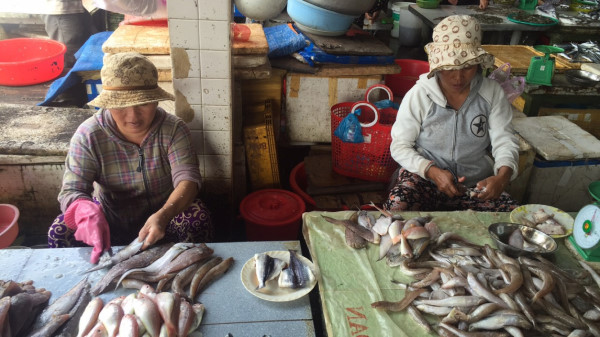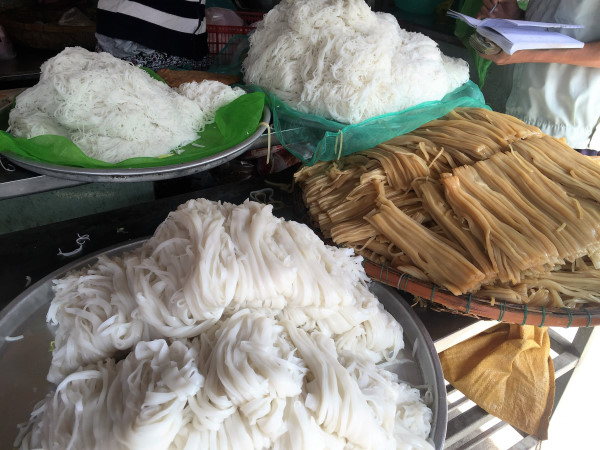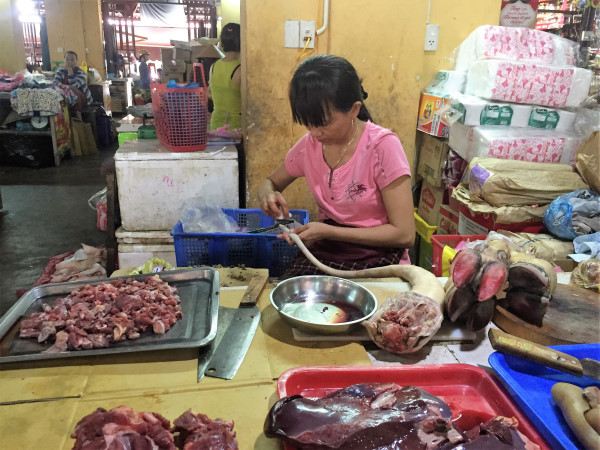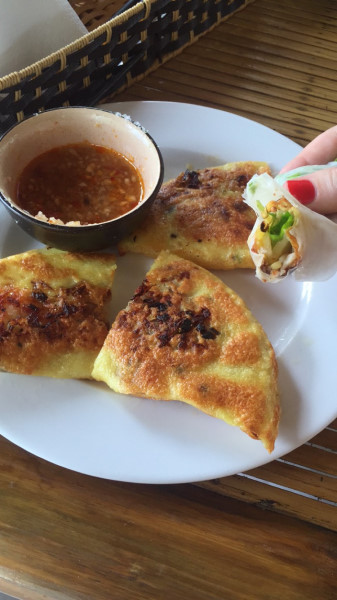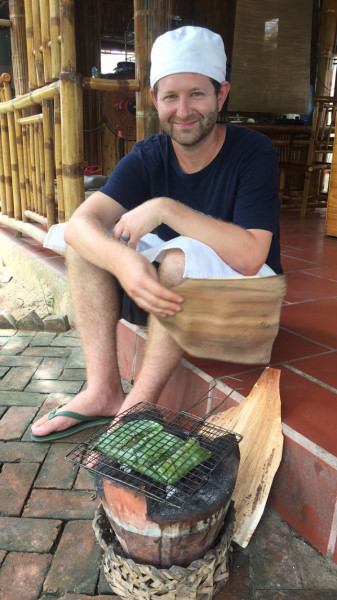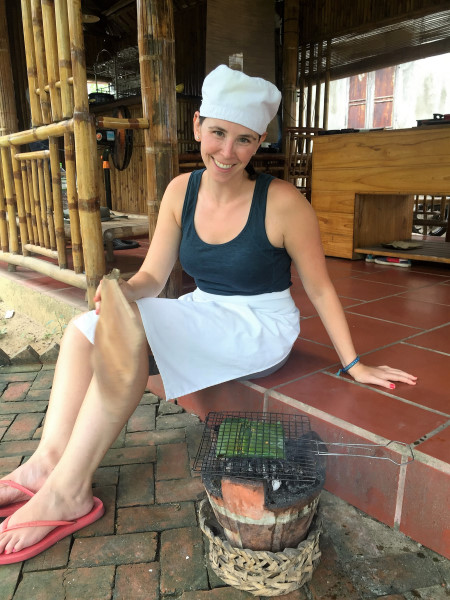Baby Mustard Cooking Class in Hoi An
One of the things I was most excited to do in Vietnam was take a cooking class. Hoi An is known for having some of the best food in Vietnam and since we were here for a few days we thought it would be the ideal city to do this. I ended up finding out about Baby Mustard through a blog I’m a fan of called The Kitchen Paper. Mary and her husband actually lived and traveled through Vietnam for almost a year and her post about Baby Mustard convinced me this was a perfect class for us. We really loved our lesson because it was very hands-on and just the two of us. Our instructor, Chef Nguyet was so sweet, patient, and extremely knowledgeable about fresh, local Vietnamese cuisine and walked us step-by-step through each recipe.
While doing a lot of TripAdvisor research I noted that a lot of other cooking classes in Hoi An either had too many people, didn’t allow you to actually cook yourselves, or the instructors didn’t speak English very well. I wanted a class where I was going to actually learn more about the Vietnamese ingredients and get some real experience practicing the recipes so I can hopefully duplicate them with similar ingredients back home.
Our day started out with Chef Nguyet picking us up from our guest house and taking us through the local Hoi An market. We’d walked through the market before but didn’t realize that the majority of the fresh fruits, vegetables, meats, fish, rice, and more come directly from the farms and rice paddies surrounding Hoi An.
Animals had sometimes been butchered that morning (some were even still alive) and fish were still flopping around. Chef Nguyet also told us how chefs like her who run a restaurant usually make two shopping trips to the market per day. Because Vietnamese people eat differently at home compared to tourists at a restaurant, different cuts of meat, sauces, and ingredients are often used. For example, she told us that Vietnamese people rarely eat the tenderloin of pork, instead opting for the belly. But western tourists are much more used to eating tenderloin so that’s what’s used in restaurants and the other cut of meat is bought for use at home.
In the process of setting up our cooking class, Nguyet sent over a list of 25+ plus Vietnamese dishes we could learn to cook, including some of Hoi An’s specialty dishes which we’d already become obsessed with two days into our visit. In the end we settled on two Hoi An specific dishes along with a more general Vietnamese dish. Part of our market tour was actually picking up the ingredients we’d be using in the dishes and we bought fresh herbs, fish, pork, noodles, pancake mix and more from the market.
It’s very interesting to me that in Chicago if you visit a restaurant that sources food locally you’ll often end up paying more for the label of “farm to table,” whereas in Vietnam and many other countries we’ve visited, shopping local actually saves you money. Same thing with visiting a farmer’s market in Chicago, we often end up paying more for fresh fruits and veggies that come from nearby farms instead of cheaper produce from Trader Joes that usually comes from California or Florida. We need to change this!!!
After visiting the market, we hopped in a cab to get to Baby Mustard restaurant located a few miles outside of Hoi An in a small farm village where each of the homes in the area grow local produce. Chef Nguyet, her parents and husband all work at the restaurant and live nearby; Baby Mustard is truly a family affair. The restaurant itself is a beautiful open-air establishment, with fields filled with rice and water buffalo on one side and a huge herb garden on the other. A small portion of the establishment is set up with four separate cooking stations for the cooking classes. While Chef Nguyet gave us a short tour of the area surrounding the restaurant and the nearby farm and homes, her family helped put together the ingredients we’d be using for class.
The first dish we’d be making was one we’d had a couple of times since arriving in Hoi An, called Bahn Xeo. Bahn Xeo is a crispy Vietnamese style crepe with whole shrimp, thinly sliced pork and bean sprouts, wrapped in thin rice paper and dipped into a sweet and sour fish sauce. Chef Nguyet walked us through all the steps from mixing the crepe mix, pan-frying the shrimp and pork, steaming the bean sprouts and putting it all together. We were both surprised that our creations were just as good as the one’s we’d been eating at the local market.
I was super excited about learning how to make our next dish of Ca Thu Nuong La Chuoi, a traditional grilled mackerel in a banana leaf, marinated with turmeric powder, spring onion, chilies and lemongrass. This was my favorite dish to make because of the freshness of all the local herbs we incorporated into the dish. It was super simple to put together and then grilled in the banana leaf over a charcoal grill which we fanned to incorporate the smoke into the fish.
If I can find some banana leaves back in Chicago this is definitely a dish I want to make for my family as soon as we get back!
The last dish we made will definitely be harder to make back at home because of the special noodles involved. Cao Lau is a Hoi An dish made with special ash-boiled noodles with pork and a super savory tomato-soy broth. Only five families in the area make the noodles and then they are sold to everyone else. Sadly, the dish is basically impossible to come by outside of Hoi An, so I’ll have to think of a similar noodle alternative back home. This dish has so many complex layers of flavor and has a broth that the longer it simmers, the more amazing it becomes.
While ours turned out pretty tasty, it’s safe to say that when you get a Cao Lau from a restaurant or market stall at the end of the day, after the flavors have been simmering for hours, it’s really the best.
Our cooking class ended up being one of my favorite activities out of our whole trip so far, and I can’t wait to make some of the things we learned back home. I’ll have to check out some local Vietnamese grocery stores in Chicago and scour Amazon for all of the ingredients I may need, but I can promise you some Vietnamese-based recipe posts in the future upon our return to the states. We learned so much about Vietnamese culture and cuisine, and I can’t recommend Baby Mustard and Chef Nguyet enough!





